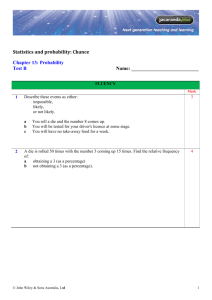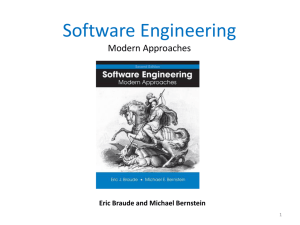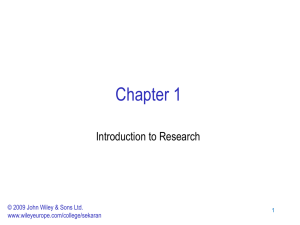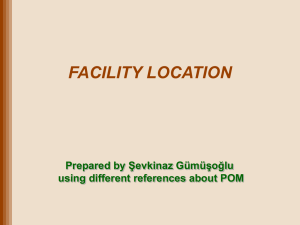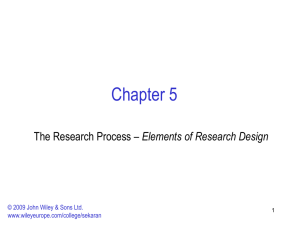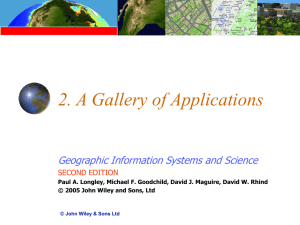ch05
advertisement
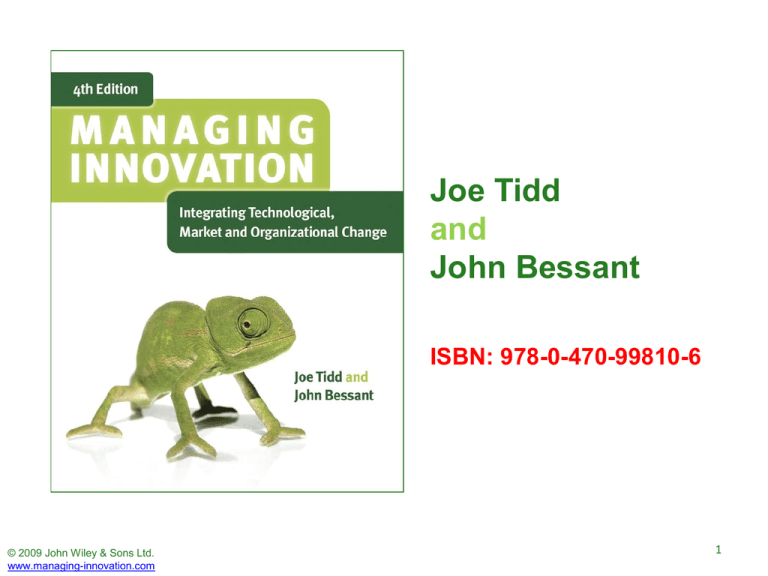
Joe Tidd and John Bessant ISBN: 978-0-470-99810-6 © 2009 John Wiley & Sons Ltd. www.managing-innovation.com 1 Chapter 5 Sources of innovation © 2009 John Wiley & Sons Ltd. www.managing-innovation.com 2 © 2009 John Wiley & Sons Ltd. www.managing-innovation.com 3 CONTENTS • • • • Introduction Sources Search tools & methods Innovation search space © 2009 John Wiley & Sons Ltd. www.managing-innovation.com 4 1. SOURCES OF INNOVATIONINTRODUCTION 5 6 1.1 Climate & Creativity “Innovation is the specific tool of entrepreneurs, the means by which they exploit an opportunity for a different business or service” – Drucker • Creativity = ideas, concepts & inventions • Entrepreneurship = couples opportunities & resources • Innovation = process of development & commercialisation © 2009 John Wiley & Sons Ltd. www.managing-innovation.com 7 Strategies for idea/concept generation: • • • • • research & analysis imitate or adapt seek inspiration consult ‘creative’ types apply systematic creativity methods & tools – Eg:SCAMPERR © 2009 John Wiley & Sons Ltd. www.managing-innovation.com 8 • Eg: China’s imitation of Mercedes:Geely 9 Business creativity training is not: • • • • • logic, research, analysis or intelligence artistic creativity / right-brain being crazy / a rebel removal of structures, inhibitions or fear brainstorming or team building © 2009 John Wiley & Sons Ltd. www.managing-innovation.com 10 Attributes of the creative mind: • conceptual fluency - multiple responses • mental flexibility - re-frame & change level • defers judgement - avoid premature analysis & criticism • tolerance - accepts ambiguous, diverse or opposing views • challenging - assumptions & authority • risk-taking - high energy, imagination © 2009 John Wiley & Sons Ltd. www.managing-innovation.com 11 Do: develop broad idea challenge everything re-frame problem multiple answers consider in-action identify obstacles Don’t: collect detailed data accept assumptions tackle given problem find the answer confuse action & solution focus on objectives celebrate success & learn from failure © 2009 John Wiley & Sons Ltd. www.managing-innovation.com 12 Some elements of business creativeness: • • • • • stop, pause, postpone decision or (re)action challenge perceptions & assumptions provoke & generate alternatives construct & test speculations & hypotheses focus © 2009 John Wiley & Sons Ltd. www.managing-innovation.com 13 2. SOURCES of INNOVATION 14 2.1 Knowledge push • Knowledge push(Pengetahuan) – Innovation that came out from scientific research – R & D processes • Eg: Intel chips • Antibiotics • CDs 15 2.2 Need pull • Need Pull(Keperluan) – “Neccessity is the mother of invention” – Particularly important at mature stages in industry/product life cycles – Eg: Energy saving cars 16 2.3 Shocks to the system • Whose needs? – Existing customers – New & potential customers eg: small entrepreneurs who want to save costs • Emerging markets – “Bottom of the pyramid”-80% under the poverty line – Eg: Poverty in Arica-created demand for cheap food in low prices 17 © 2009 John Wiley & Sons Ltd. www.managing-innovation.com 18 2.4 Advertising and mass customization • Challenge in markets-buyers want variety and customization at the same time • Eg: Rising individuality has opened up new market for customized products 19 © 2009 John Wiley & Sons Ltd. www.managing-innovation.com 20 © 2009 John Wiley & Sons Ltd. www.managing-innovation.com 21 2.5 Users as innovators • Create innovative solutions on a continuing basis • Eg: Tech-hobbyists keep on providing ideas on technological innovations-new models for pc, phones 22 2.6 Extreme Users • “Tough customers mean good designs” • The users in the toughest environments may have needs which by definition are at edge • Eg: Military needs inspire more innovations within the security industry 23 2.7 Watching Others • Concept of benchmarking • Eg: Korea manufacturing field that came from the concept of “copy and develop” 24 2.8 Combination & recombination • ‘Crossover’ • Combination of industries • Eg: Nike fashionable shock-absorbing shoescombination of arts, health and fitness industry 25 2.9 Regulation • Restrict certain things and opens up new ones • Eg: New tax rules on cigarettes- restricts sales of cigarettes, opens up new market of ‘fake cigarettes’ and aids to quit smoking 26 2.10 Futures and forecasting • Exploring alternatives • Eg; Exxon and Shell exploring possibilities for alternatives for oil and gas 27 2.11 Accidents • Mistakes that turned out to be important inventions 28 3. TOOLS FOR INNOVATION SOURCES 29 3.1 Internal knowledge connections • Important to recognize that much of the knowledge lies in the experience and ideas of ordinary employees rather than solely with specialists in formal innovation depts like R & D or market research • Internal entrepreneurs=“intrapreneurship” 30 3.2 External connections • Key stakeholders 31 3.3 TOOLS OF INNOVATION SOURCES-SUMMARY 32 © 2009 John Wiley & Sons Ltd. www.managing-innovation.com 33 3.4 Exercise-SCAMPER • • • • • • • • S Substitute- Remove some part of the accepted situation, thing, or concept and replace it with something else. C Combine -Join, affiliate, or force together two or more elements of your subject matter and consider ways that such a combination might move you toward a solution. A Adapt-Change some part of your problem so that it works where it did not before. M Minify/Magnify- Consider many of the attribute of the thing you're working on and change them, arbitrarily, if necessary. Attributes include: size, shape, other dimensions, texture, color, attitude, position, history, and so on. P Purpose (Put to other use)-Modify the intention of the subject. Think about why it exists, what it is used for, what it's supposed to do. Challenge all of these assumptions and suggest new and unusual purposes. E Eliminate-Arbitrarily remove any or all elements of your subject, simplify, reduce to core functionality R Reverse- Change the direction or orientation. Turn it upside-down, inside-out, or make it go backwards, against the direction it was intended to go or be used. R Rearrange -Similar to Reverse, modify the order of operations or any other hierarchy involved. 34 • You are a product executive for Perodua and you need to come up with a new eco-friendly Perodua model based on Viva. Using SCAMPERR, invent a new innovative product suitable for the global market. 35 4. CONCLUSIONS 36 • There are various sources of innovation and creativity • Innovation process can be triggered 37

